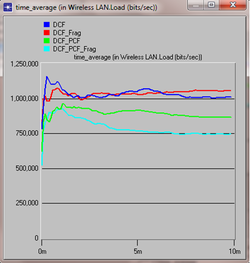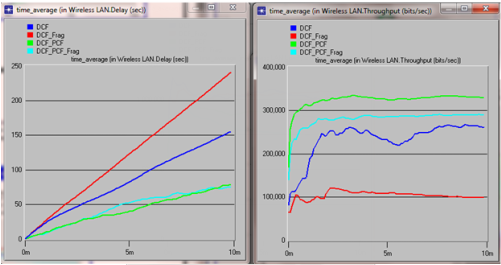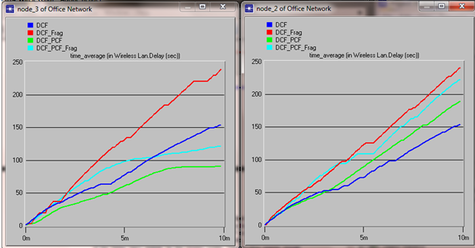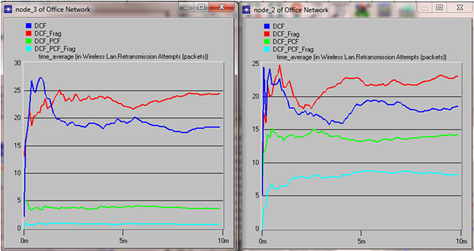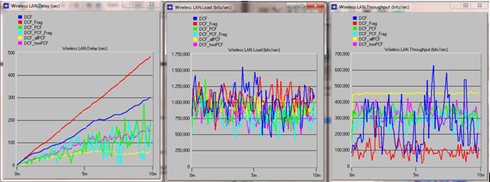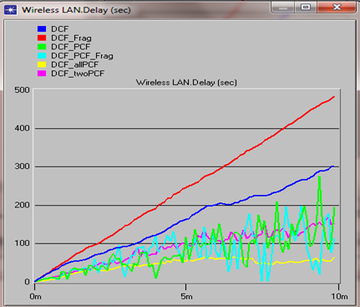Joel P. Schroeder
Course Description:
IS 375 - Server-based Networking & Security
This course is titled Networks and Security. It is the study of enterprise networking from a server operating system perspective. Theory and practice of topics such as domain creation, Active Directory management and delegation, scripting, security policies, roaming profiles, access permissions, and security auditing.
This course uses a network simulation software called OPNET in which labs will be conducted to demonstrate and construct different network scenarios.
Information Systems 375
Lab 7a
Wireless Local Area Network
10/9/2010
Medium Access Control for Wirelessly Connected Stations
Objective:
This lab addresses the MAC (Medium Access Control) sublayer of the IEEE 802.11 standard for WLAN (wireless local area network). Different options of this standard are studied in this lab. The performance of these options is analyzed under different scenarios.
Overview:
The IEEE 802.11 standard provides wireless connectivity to computerized stations that require rapid deployment such as portable computers. The Medium Access Control (MAC) sublayer in the standard includes two fundamental access methods: distributed coordination function (DCF) and the point coordination function (PCF). DCF utilizes the carrier sense multiple access with collision avoidance (CSMA/CA) approach. DCF is implemented in all stations in the wireless local area network (WLAN). PCF is based on polling to determine the station that can transmit next. Stations in an infrastructure network optionally implement the PCF access method.
In addition to the physical CSMA/CA, DCF and PCF utilize virtual carrier-sense mechanism to determine the state of the medium. This virtual mechanism is implemented by means of the network allocation vector (NAV). The NAV provides each station with a prediction of future traffic on the medium. Each station uses NAV as an indicator of time periods during which transmission will not be initiated even if the station senses that the wireless medium is not busy. NAV gets the information about future traffic from management frames and the header of regular frames being exchanged in the network. With DCF, every station senses the medium before transmitting. The transmitting station defers as long as the medium is busy. After deferral and while the medium is idle, the transmitting station has to wait for a random backoff interval. After the backoff interval and
if the medium is still idle, the station initiates data transmission or optionally exchanges RTS (request to send) and CTS (clear to send) frames with the receiving station. The effect of RTS and CTS frames will be studied in the following lab.
With PCF, the access point (AP) in the network acts as a point coordinator (PC). The PC uses polling to determine which station can initiate data transmission. It is optional for the stations in the network to participate in PCF and hence respond to poll received from the PC. Such stations are called CF-Pollable stations. The PCF requires control to be gained of the medium by the PC. To gain such control, the PC utilizes the Beacon management frames to set the network allocation vector (NAV) in the network stations. As the mechanism used to set NAV is based on the DCF, all stations comply with the PC request to set their NAV whether or not they are CF-Pollable. This way the PC can control frame transmissions in the network by generating contention free periods (CFP). The PC and the CF-Pollable stations do not use RTS/CTS in the CFP.
The standard allows for fragmentation of the MAC data units into smaller frames. Fragmentation is favorable in case the wireless channel is not reliable enough to transmit longer frames. Only frames with a length greater than a fragmentation threshold will be fragmented. Each fragment will be sent independently and will be separately acknowledged. During a contention period, all fragments of a single frame will be sent as burst with a single invocation of the DCF medium access procedure. In case of PCF and during a contention free period, fragments are sent individually following the rules of the point coordinator (PC).
Exercises:
1) Based on the definition of the statistic Load, explain why with PCF enabled the load is lower than if DCF is used without PCF. Load represents the total load (in bits/sec) submitted to wireless LAN layers by all other higher layers in all WLAN nodes of the network. This statistic does not include the bits of the higher layer packets that are dropped by WLAN MACs upon arrival and not considered for transmission due to, for example, insufficient space left in the higher layer packet buffer of the MAC. Simply put, fewer bits are sent to the network because with PCF enabled, the network is polling the system for open stations to initiate data transmission.
2) Analyze
the graphs that compare the Delay and Throughput of the four scenarios. What are the effect of
utilizing PCF and fragmentation on these two statistics?
The effects of utilizing PCF and fragmentation on the end to end delay are that without PCF or fragmentation of data, the delay is increased significantly. While if only fragmentation is enabled, the delay is even greater.
As PCF and fragmentation are enabled, throughput increases, but if fragmentation of data is enabled alone, functionality of the network drops substantially.
The effects of utilizing PCF and fragmentation on the end to end delay are that without PCF or fragmentation of data, the delay is increased significantly. While if only fragmentation is enabled, the delay is even greater.
As PCF and fragmentation are enabled, throughput increases, but if fragmentation of data is enabled alone, functionality of the network drops substantially.
3) From
the last four graphs, explain how the performance of a node without PCF is affected by having PCF enabled in
other nodes in the network.
In the graphs below, node 3 has PCF enabled and node 2 does not. You can then see the effect PCF has on both LAN Delay and Retransmission Attempts in the PCF_DCF scenario. Node 3 experiences fewer delays and retransmissions because it is PCF knows which station can transmit next allowing for fewer delays and fewer collisions.
In the graphs below, node 3 has PCF enabled and node 2 does not. You can then see the effect PCF has on both LAN Delay and Retransmission Attempts in the PCF_DCF scenario. Node 3 experiences fewer delays and retransmissions because it is PCF knows which station can transmit next allowing for fewer delays and fewer collisions.
4) Create
two new scenarios as duplicates of the DCF_PCF scenario. Name the first
new scenario DCF_allPCF and the
second new scenario DCF_twoPCF. In DCF_allPCF, enable the PCF
attribute in all 8 nodes: node_1 through node_8
(Note: do not include node_0 in any of
your attribute editing). In DCF_twoPCF,
disable the PCF attribute in node_3
and node_5 (this will leave only node_1 and
node_7 with PCF enabled). Generate the
graphs for the Delay, Load, and
Throughput statistics and explain how the number of PCF nodes might affect the performance of the wireless network.
Looking at just the DCF_PCF scenario when comparing to these new scenarios we’ve just created, there is a lot more fluctuation in delay times. As we add more PCF enabled wireless LAN stations these delays begin to stabilize. It’s a bit hard to read the second graph showing the load of these stations as the amount of bits/sec transmitted are all over the place. It does appear that the more stations added that have PCF enabled, the lower the performance on average. In the last graph showing throughput, it is quite clear that as the number of PCF stations increases so does throughput. This is due again to the concept that these stations already have information as to which station to transmit to next saving time spend configuring routes.
Throughput statistics and explain how the number of PCF nodes might affect the performance of the wireless network.
Looking at just the DCF_PCF scenario when comparing to these new scenarios we’ve just created, there is a lot more fluctuation in delay times. As we add more PCF enabled wireless LAN stations these delays begin to stabilize. It’s a bit hard to read the second graph showing the load of these stations as the amount of bits/sec transmitted are all over the place. It does appear that the more stations added that have PCF enabled, the lower the performance on average. In the last graph showing throughput, it is quite clear that as the number of PCF stations increases so does throughput. This is due again to the concept that these stations already have information as to which station to transmit to next saving time spend configuring routes.
5) For
all scenarios, select the Media Access Delay statistic from the Global
Statistics -> Wireless LAN hierarchy. Re-run the simulation
for all scenarios.
Generate the graph that compares the Media
Access Delay statistic of all
scenarios. Analyze the graph
explaining the effect of PCF, fragmentation, and
number of PCF nodes on media access
delay.
DCF with packet fragmentation has the highest delay rate. I feel this is the slowest because the data has to be separated and then reassembled which will consume the most time and effort. When adding stations with PCF enabled on them, we see that the delay decreases, but as we convert all stations to having PCF, we see that the delay rate drops substantially
DCF with packet fragmentation has the highest delay rate. I feel this is the slowest because the data has to be separated and then reassembled which will consume the most time and effort. When adding stations with PCF enabled on them, we see that the delay decreases, but as we convert all stations to having PCF, we see that the delay rate drops substantially
6) “What are the business
implications of the behavior seen in this lab?
As wireless connectivity becomes increasingly more useful in business today, it is important to understand how we can manipulate properties of these wireless devices to help maximize performance depending on what characteristics we feel are most important. Of course we want to minimize delay rates or increase throughput and knowing how to create an environment that supports these concepts is very important.
As wireless connectivity becomes increasingly more useful in business today, it is important to understand how we can manipulate properties of these wireless devices to help maximize performance depending on what characteristics we feel are most important. Of course we want to minimize delay rates or increase throughput and knowing how to create an environment that supports these concepts is very important.

